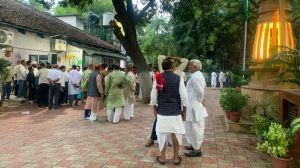Sending smoke signals to the tobacco industry
AUGUST 30: Sachin Tendulkar may sport a Wills logo, but he does not smoke. He knows that if he did, he would in all probability end up a ...

AUGUST 30: Sachin Tendulkar may sport a Wills logo, but he does not smoke. He knows that if he did, he would in all probability end up a respiratory cripple like the 70 lakh other Indians who suffer from tobacco-related chronic obstructive lung disease. No more centuries for Sachin then, for he would be wheezing and panting for breath after each run. But do the millions of his impressionable young fans know this?
They don’t, and are not likely to be ever told. Just as they don’t know that the logo he sports also stands for a brand of sportswear. The tobacco industry at least won’t be any wiser, which spends a fortune devising ways to get around the ban on tobacco advertising on the electronic media through surrogate advertising and brand stretching.
The Cigarette Act of 1975 requires packets of cigarettes and pan masalas to bear health warnings, but the statutory warning — `Cigarette smoking is injurious to health’ — is barely visible because of the small print. This was one of the things that promptedMurli Deora, four-time South Mumbai representative to the Lok Sabha and President, Forum for Action Against Consumption of Tobacco, to file a public interest petition on July 10 in the Supreme Court “to regulate, control and combat the lethal trade in tobacco products”. “Why don’t they simply say, smoking kills?” he questions.
Deora is asking for a Rs 500 crore compensation from the tobacco industry for a Healthcare and Awareness Fund under the Ministry of Health.
More than anything else what prompted Deora to go ahead was the fact that most of the advertising was targeting the young. “In India, over 2 crore children below 18 years are addicted to tobacco and some 55,000 are taking to it every day,” alleges Deora. Most of these 55,000 children end up getting addicted for life. Nicotine is an addictive drug, more addictive than alcohol, cocaine, marijuana and heroin, a fact known for decades by the international tobacco industry, but suppressed because of commercial interests.
Still, tax on rawtobacco was abolished in 1979 to prevent “harassing” farmers. What’s more, the government offers a 450 per cent support price to tobacco, compared to the 150 support price for food crops. Does it mean that the government think we need tobacco more than food, just because it is an important cash crop which earns us Rs 1,059 crore in exports and Rs 6,934 in excise.
Hardly. The Indian Council of Medical Research puts the annual death toll of tobacco-related diseases in India at 8 lakh, that is, more than 2,200 deaths every day. Tobacco smoke has more than 4,000 chemicals, of which at least 43, are definitely carcinogenic. And of the nearly 6.45 cancers reported every year, it causes half of the cancers among men and a fourth among women. Lung cancer risk goes up 20 times for smokers who consume ore than a pack a day.
According to the World Health Organisation (WHO), tobacco-related diseases kill more people every year than AIDS, alcohol, accidents, homicides and drugs put together! A study by theMumbai-based Tata Institute of Fundamental Research (TIFR) found that tobacco consumption, which is known to cause heart ailments, impotence and gangrene, causes more amputations than accidents.
And tobacco is adding to the existing pollution problem: a WHO 1998-99 study in collaboration with the World Resources Institute revealed that children in Indian metropolitan cities passively smoke pollutants equal to forty cigarettes a day. “A serious new problem is the growing popularity of pan masala (betel quid mixture), which continues to be vigorously advertised, promoted and marketed, especially among the young,” says Dr Prakash C. Gupta of the Epidemiology Research Unit, TIFR.
But there is some good news. The Tobacco Institute of India (TII) recorded an 8.5 per cent drop in cigarette sales and production from April to June this year, as compared to the same period last year, which TII largely contribute to “health propaganda”. “The decline is due to the continuous impact of high excise duties in thepast two years, but we expect sales to shoot up during the festive season, when people tend to spend more,” says A. C. Sarkar, President, Tobacco Institute of India, refusing to say die.
He attributes the decline to the ban on the sale of cigarettes at railway stations, which accounted for roughly 30 per cent of the sales. Added to this are similar bans imposed on flights by airlines, smoking in public places by state governments as in Kerala, and additional luxury tax of 5 per cent on value in Orissa and Tamil Nadu. Smoking has been banned in all health establishments, government offices, educational institutions, air-conditioned railway carriages, buses and flights since 1990, though enforcement is lax, as can be seen in Delhi.
What it does show, however, is that a little effort on the part of the government can go a long way.






- 01
- 02
- 03
- 04
- 05

























